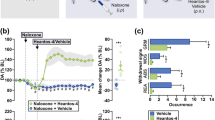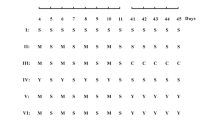Abstract
Previous studies showed the attenuation of both morphine-dependence and morphine-place preference by zinc. Conditioned place preference and aversion are experimental models frequently used to test the reward-stimulating, respectively the aversive effects induced by different stimuli or substances. Addictive substances usually induce place preference (exhibit reward-stimulating properties), while their antagonists determine place-avoidance (aversion). The present study aimed to assess the effect determined by zinc sulphate oral administration (2 and 4 mg/kg/day, 14 days, prior to habituation) on the place aversion induced by two naloxone doses (1.5 and 2.5 mg/kg/administration). The results show a robust, dose-dependent reduction of the aversion determined by both naloxone doses (the aversion induced by 1.5 mg/kg naloxone was reduced with 15%—the lower zinc dose and with 24%—the higher zinc dose; the aversion induced by 2.5 mg/kg naloxone was reduced with 16%—the lower zinc dose and with 29%—the higher zinc dose). This represents a new proof of the interactions between zinc and opioidergic system and a further argument for dietary zinc supplementation in patients on opioids for cancer-related chronic pain.





Similar content being viewed by others
References
Laity JH, Lee BM, Wright PE (2001) Zinc finger proteins: new insights into structural and functional diversity. Curr Opin Struct Biol 11:39–46
Osredkar J, Sustar N (2011) Copper and zinc, biological role and significance of copper/zinc imbalance. J Clinic Toxicol S 3:1–18
Dhawan DK, Chadha VD (2010) Zinc: a promising agent in dietary chemoprevention of cancer. Indian J Med Res 132:676–682
Livingstone C (2015) Zinc: physiology, deficiency, and parenteral nutrition. Nutr Clin Pract 30(3):371–382
Bonaventura P, Benedetti G, Fand A, Miossec P (2015) Zinc and its role in immunity and inflammation. Autoimmun Rev 14:277–285
Ciubotariu D, Ghiciuc CM, Lupușoru CE (2015a) Zinc involvement in opioid addiction and analgesia—should zinc supplementation be recommended for opioid-treated persons? Subst Abuse Treat Prev Policy 10:29
Ciubotariu D, Nechifor M (2007) Zinc involvements in the brain. Rev Med Chir Soc Med Nat 111:981–985
Ciubotariu D, Pascu Baican M, Nechifor M, Tartau L (2012) P.1.c.010 zinc does not affect morphine analgesia in morphine-dependent rats. European Neurospsychopharmacol 22(Suppl. 2):S172
Larson AA, Kovács KJ, Spartz AK (2000) Intrathecal Zn2+ attenuates morphine antinociception and the development of acute tolerance. Eur J Pharmacol 407:267–272
Chelărescu D, Filip C, Ghiciuc C, Cuciureanu M, Chelărescu O (2011) P.6.d.019 zinc modulates morphine-induced behavioural sensitisation. European Neurospsychopharmacol 21(Suppl. 3):S593
Connor MA, Chavkin C (1992) Ionic zinc may function as an endogenous ligand for the haloperidol-sensitive sigma 2 receptor in rat brain. Mol Pharmacol 42:471–479
Hanissian SH, Tejwani GA (1988) Histidine abolishes the inhibition by zinc of naloxone binding to opioid receptors in rat brain. Neuropharmacology 27:1145–1149
Stengaard-Pedersen K (1982) Inhibition of enkephalin binding to opiate receptors by zinc ions: possible physiological importance in the brain. Acta Pharmacol Toxicol (Copenh) 50:213–220
Tejwani GA, Hanissian SH (1990) Modulation of mu, delta and kappa opioid receptors in rat brain by metal ions and histidine. Neuropharmacology 29950:445–452
Ogawa N, Mizuno S, Fukushima M, Mori A (1985) Effects of guanine nucleotides, transition metals and temperature on enkephalin receptors of rat brain membranes. Peptides 6(Suppl 1):23–28
Essatara MB, Morley JE, Levine AS, Elson MK, Shafer RB, McClain CJ (1984) The role of the endogenous opiates in zinc deficiency anorexia. Physiol Behav 32:475–478
Fregoneze JB, Luz CP, Castro L, Oliveira P, Lima AK, Souza F, Maldonado I, Macêdo DF, Ferreira MG, Bandeira IP, Rocha MA Jr, Carvalho FL, De-Castro-e-Silva E (1999) Zinc and water intake in rats: investigation of adrenergic and opiatergic central mechanisms. Braz J Med Biol Res 32:1217–1222
Bardo MT, Bevins RA (2000) Conditioned place preference: what does it add to our preclinical understanding of drug reward? Psychopharmacology 153:31–43
Zarrindast MR, Bahreini T, Adl M (2002) Effect of imipramine on the expression and acquisition of morphine-induced conditioned place preference in mice. Pharmacol Biochem Behav 73:941–949
Tenk CM, Kavaliers M, Ossenkopp KP (2006) The effects of acute corticosterone on lithium chloride-induced conditioned place aversion and locomotor activity in rats. Life Sci 79:1069–1080
Koob GF, Le Moal M (2001) Drug addiction, dysregulation of reward, and allostasis. Neuropsychopharmacology 24:97–129
Shirayama Y, Chaki S (2006) Neurochemistry of the nucleus accumbens and its relevance to depression and antidepressant action in rodents. Curr Neuropharmacol 4:277–291
Brischoux F, Chakraborty S, Brierley DI, Ungless MA (2009) Phasic excitation of dopamine neurons in ventral VTA by noxious stimuli. Proc Natl Acad Sci U S A 106:4894–4899
Stamatakis AM, Stuber GD (2012) Activation of lateral habenula inputs to the ventral midbrain promotes behavioral avoidance. Nat Neurosci 15:1105–1107
van der Kooy D, Mucha RF, O'Shaughnessy M, Bucenieks P (1982) Reinforcing effects of brain microinjections of morphine revealed by conditioned place preference. Brain Res 243:107–117
Phillips RG, LeDoux JE (1992) Differential contribution of amygdala and hippocampus to cued and contextual fear conditioning. Behav Neurosci 106:274–285
Bohn LM, Gainetdinov RR, Sotnikova TD, Medvedev IO, Lefkowitz RJ, Dykstra LA, Caron MG (2003) Enhanced rewarding properties of morphine, but not cocaine, in beta(arrestin)-2 knock-out mice. J Neurosci 23:10265–10273
Kawasaki Y, Araki H, Suemaru K, Kitamura Y, Gomita Y, Sendo T (2011) Involvement of dopaminergic receptor signaling in the effects of glutamatergic receptor antagonists on conditioned place aversion induced by naloxone in single-dose morphine-treated rats. J Pharmaco Sci 117:27–33
van der Kooy D, Swerdlow NR, Koob GF (1983) Paradoxical reinforcing properties of apomorphine: effects of nucleus accumbens and area postrema lesions. Brain Res 259:11–118
Bueters TJ, Joosen MJ, van Helden HP, Ijzerman AP, Danhof M (2003) Adenosine A1 receptor agonist N6-cyclopentyladenosine affects the inactivation of acetylcholinesterase in blood and brain by sarin. J Pharmacol Exp Ther 304:1307–1313
Qiu J, Zhang C, Borgquist A, Nestor CC, Smith AW, Bosch MA, Ku S, Wagner EJ, Rønnekleiv OK, Kelly MJ (2014) Insulin excites anorexigenic proopiomelanocortin neurons via activation of canonical transient receptor potential channels. Cell Metab 19:682–693
Pfaender S, Grabrucker AM (2014) Characterization of biometal profiles in neurological disorders. Metallomics 6:960–977
Prasad AS (2013) Discovery of human zinc deficiency: its impact on human health and disease. Adv Nutr 4:176–190
Alexa T, Marza A, Voloseniuc T, Tamba B (2015) Enhanced analgesic effects of tramadol and common trace element coadministration in mice. J Neurosci Res 93:1534–1541
Kesmati M, Torabi M (2014) Interaction between analgesic effect of nano and conventional size of zinc oxide and opioidergic system activity in animal model of acute pain. Basic Clin Neurosci 5:80–87
Larson AA, Kitto KF (1999) Chelation of zinc in the extracellular area of the spinal cord, using ethylenediaminetetraacetic acid disodium-calcium salt or dipicolinic acid, inhibits the antinociceptive effect of capsaicin in adult mice. J Pharmacol Exp Ther 288:759–765
Liu T, Walker JS, Tracey DJ (1999) Zinc alleviates thermal hyperalgesia due to partial nerve injury. Neuroreport 10:645–649
Matsunami M, Kirishi S, Okui T, Kawabata A (2011) Chelating luminal zinc mimics hydrogen sulfide-evoked colonic pain in mice: possible involvement of T-type calcium channels. Neuroscience 181:257–264
Nozaki C, Vergnano AM, Filliol D, Ouagazzal AM, Le Goff A, Carvalho S, Reiss D, Gaveriaux-Ruff C, Neyton J, Paoletti P, Kieffer BL (2011) Zinc alleviates pain through high-affinity binding to the NMDA receptor NR2A subunit. Nat Neurosci 14:1017–1022
Tamba BI, Leon MM, Petreus T (2013) Common trace elements alleviate pain in an experimental mouse model. J Neurosci Res 91:554–561
Gulya K, Kovács GL, Kása P (1991) Partial depletion of endogenous zinc level by (D-Pen2, D-Pen5)enkephalin in the rat brain. Life Sci 48:PL57–PL62
Freisinger E, Vašák M (2013) Cadmium in metallothioneins. Met Ions Life Sci 11:339–371
Hidalgo J, Giralt M, Garvey JS, Armario A (1991) Effect of morphine administration on rat liver metallothionein and zinc metabolism. J Pharmacol Exp Ther 259:274–278
Ciubotariu D, Ghiciuc CM, Lupușoru RV, Bibire N, Agoroaei L, Lupușoru CE (2015b) Experimental research showing the beneficial effect of oral zinc administration in opioid tolerance. Farmacia 63:835–839
Elnimr T, Hashem A, Assar R (1996) Heroin dependence effects on some major and trace elements. Biol Trace Elem Res 54:153–162
Potkin SG, Shore D, Torrey EF, Weinberger DR, Gillin JC, Henkin RI, Agarwal RP, Wyatt RJ (1982) Cerebrospinal fluid zinc concentrations in ex-heroin addicts and patients with schizophrenia: some preliminary observations. Biol Psychiatry 17:1315–1322
Ruiz Martínez M, Gil Extremera B, Maldonado Martín A, Cantero-Hinojosa J, Moreno-Abadía V (1990) Trace elements in drug addicts. Klin Wochenschr 68:507–511
Sadlik J, Pach J, Winnik L, Piekoszewski W (2000) Concentration of zinc, copper and magnesium in the serum of drug addicts. Przegl Lek 57:563–564
Floriańczyk B (2000) Zinc level in selected tissues of ethanol and morphine intoxicated mice. Med Sci Monit 6:680–683
Cuajungco MP, Lees GJ (1997) Zinc metabolism in the brain: relevance to human neurodegenerative disorders. Neurobiol Dis 4:137–169
Fosmire GJ (1990) Zinc toxicity. Am J Clin Nutr 51:225–257
Dursun N, Erenmemisoglu A, Suer C, Gogusten B (1995) The effect of zinc deficiency on morphine antinociception. Research and Communication in Alcohol and Substance Abuse 16:47–52
Author information
Authors and Affiliations
Corresponding author
Ethics declarations
The study protocols were approved by the institution’s Ethics Committee of Research (“Gr. T. Popa” University of Medicine and Pharmacy from Iași, Romania). All animal procedures were performed in accordance with the European Union law on the care and use of animals for scientific purposes and with the Helsinki Declaration recommendations.
Conflict of Interest
The authors declare that they have no conflict of interest.
Rights and permissions
About this article
Cite this article
Ciubotariu, D., Lupușoru, R.V., Luca, E. et al. Experimental Research Showing the Reduction of Naloxone-Place Aversion by Oral Zinc Administration in Rats. Biol Trace Elem Res 180, 127–134 (2017). https://doi.org/10.1007/s12011-017-0995-1
Received:
Accepted:
Published:
Issue Date:
DOI: https://doi.org/10.1007/s12011-017-0995-1




